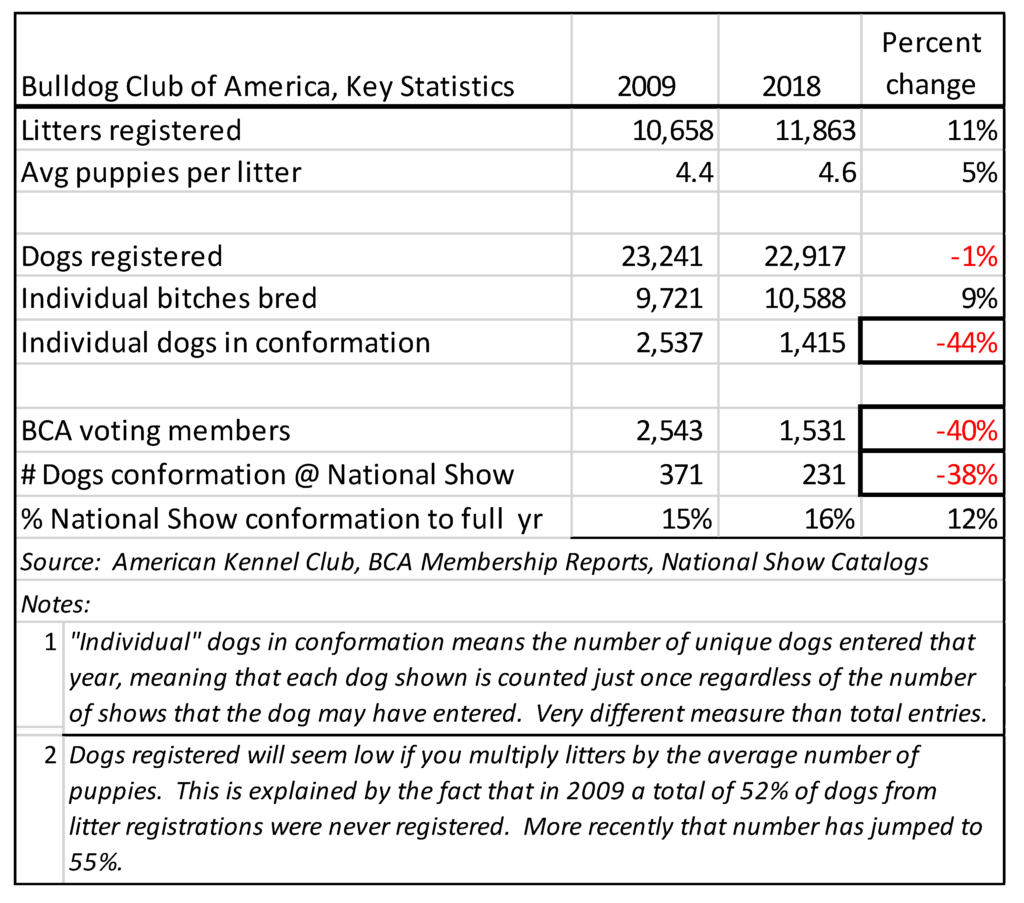by: Former BCA President Link Newcomb, submitted to the AKC Perspectives Newsletter
Here’s a chicken and egg question for my fellow delegates. Is the Bulldog Club of America (BCA) losing club members because of a significant decline in the number of bulldogs being shown today compared to a decade ago? Or are we experiencing a substantial decline in the number of bulldogs being shown today because BCA has lost a thousand members over the past decade?
Bulldogs are amazing animals but I’ve yet to see one drive itself to a dog show so my conclusion is that a declining membership has led to a decline in conformation show dogs.
This article gleans key facts from the annual breed statistics provided to parent clubs by AKC (“AKC Statistics”), offers one possible explanation for the trends we see and proposes one plan of action that could at least partially respond to the dire situation.
Coincidentally, or maybe not so coincidentally, BCA membership numbers mirror this trend. BCA had 1,531 voting members at the end of last year.
- This decade BCA has lost 4 times more members (1,012) than it did in the last decade. Keep in mind bulldogs are not a rare breed. Our breed remains wildly popular with the public.
- To fill the increasing demand of puppy buyers, there were over a thousand more litters born in 2018 than in 2009. I’ve been involved in our sport my whole life and these numbers shock me to the core.
- In one decade we’ve lost over a thousand members and over a thousand show dogs, in spite of an increase of a thousand litters! At this rate we’d virtually be a thing of the past in 15 more years. Sustainability is a very real topic for discussion.
What can we do now as an organization to turn this trend around?
There are very significant financial consequences to BCA as a result of the negative trends shown in the chart. The cost in membership alone is obvious. Among other realities, the per member cost to publish the Bulldogger has dramatically jumped. At the Bulldog National in 2009 in Kansas City, about 15% of all bulldogs shown that year in conformation entered the show. At the time that translated to an outstanding entry of 371 dogs. As the chart shows, we actually increased last year to 16% of available dogs entering in conformation at our Bulldog National in Minneapolis. However, on last year’s available pool of dogs, that meant an entry of only 231. With hotel venues large enough to accommodate our group getting more and more expensive, we are quickly turning upside down financially trying to pay the bill for the National Show with fewer members, fewer exhibitors and fewer dogs.
More dogs available to be shown, but far fewer getting to the ring. How does this relate back to BCA membership? Ms. Canalizo’s article reminded me that BCA’s membership is, in effect, a derivative of the membership levels in all the local bulldog specialty clubs. Most people join a local club first and graduate to BCA. So BCA’s membership challenge is almost certainly a result of membership declines experienced in our local clubs. I believe there is an explanation that ties all these facts together. Our local membership challenge and the decline in bulldogs being shown both stem fundamentally from changes in what breeders are doing with the puppies they raise.
We as breeders are not sufficiently identifying puppy buyers who might be candidates to join the local club and show their new dog.
Why is that? Here’s my hypothesis. Most indicators suggest that demand for bulldogs is stronger in 2019 than it was a decade ago. Both the number of puppies and puppy prices are higher. Demand is so strong
that breeders maintain waiting lists for puppies, and so the little darlings go from whelping boxes directly to wonderful new homes. It’s a simple and efficient process. But what’s missing from this picture?
By attempting to satisfy the growing demand for bulldog companions from pet buyers, we’re bypassing the chance to use outstanding puppies to attract new participants to our sport.
Here’s an illustrative example. I spoke earlier this year to a well- regarded, successful breeder who whelped eight litters last year. This individual kept a handful of nice puppies from the litters and said they will provide that breeder with show prospects for the next three years even without whelping another litter. What about selling some of the puppies to show homes? This individual chose not to go down that path. Instead, they get great satisfaction in knowing that every puppy sold is going to be treated like a member of the buyer’s family and should live a wonderful life. Show dogs may not fare as well. Besides, why put yourself through the aggravation of selling an eight-week old puppy to be a show dog when you have plenty of pet buyers that will provide great family homes? No one can guarantee that an eight-week old puppy will mature into a show dog anyway. It’s also time consuming to mentor new puppy buyers about what is entailed in turning the family pet into a show dog.
This breeder may accurately describe the situation, but if BCA breeders don’t identify and cultivate show home buyers for their best puppies--in particular buyers that would represent new participants in our sport--then our local clubs lose their most important source of new members. Ultimately, BCA suffers the same fate as shown in the numbers above, and AKC loses out too because there are far fewer bulldogs being shown.
After analyzing the AKC Statistics, by my estimation, we’re missing just one show dog from every ten litters born. However, since BCA membership is declining and litters are on the rise, BCA members are responsible for a declining share of the litters born. I’m working with AKC staff now to determine just how many of the nearly 12,000 bulldog litters registered last year named one or more BCA members as a breeder. Sadly, I’m afraid it will be no more than about 10%, or 1,200 litters. We need a goal. If BCA households can produce 1,200 litters a year, which is probably about 1.5 litters per BCA household, then the math tells us that BCA members could add 600 dogs into conformation by placing one incremental puppy into a show home out of every two litters raised. That by itself would translate into just over a 40% increase in the number of dogs being shown. Seriously my friends, we cannot sustain our membership—our very existence--if all breeders simply retain puppies to show themselves and place all the rest in pet homes. If everyone did that, how would we EVER get new blood into the sport?
“Just One More” is my personal rallying cry. Just one more puppy into a show home, and the rest of the benefits will fall into place. One simple idea is to reach out to former members who may have left the show dog community to focus on family matters and may be ready to dive back in, if a new show puppy offers them that opportunity. I would like to push our successful BCA breeder referral program into finding better, more efficient ways to connect those puppy buyers who may express some interest in showing with those breeders who have puppies with show ring potential. Our breeder referral program is very successful at connecting pet buyers with quality breeders, but we make no effort to connect interested buyers with show prospects. That needs to change, just like our website (which will launch new in August 2019) and the breed information flyer mentioned above.
There’s a glimmer of hope. The 2019 BCA National Show is returning to California for the first time since 2012. In 2012, we drew 12.5% of the 2,189 bulldogs that showed at one point or another that year for a total conformation entry of 274. Our entries out west are in a state of decline in general, so I think it’s predictable that this year’s National will attract no more than about 12.5% of all the available bulldogs being shown. Based on the available dogs from 2018, this would project an entry of 177 dogs, almost a hundred fewer than we had in 2012. However, the 2019 AKC mid-year statistics for conformation may provide hope for a better turnout. Bulldog entries may finally have turned the tide. For the first time in over ten years, unique bulldogs shown in competition for the first six months of this year actually increased from the same period a year ago. It’ only a 1% increase, but that is still a big swing from the almost predictable 10 % declines we’ve had every year. If that trend holds, maybe we’d be able to draw a few more entries from this improved availability. Wouldn’t that be a nice change? Let’s hope this is the first positive sign of a turnaround, and we as a club do what is necessary to see it continue.
So here’s the call to action:
If every BCA household would commit to getting one additional puppy into a show home from every two litters they raise and encourage those buyers to join their local bulldog club, it would immediately reverse the decline in dogs shown, reverse those clubs’ membership declines, and then if those same individuals joined BCA a year later, it would stem BCA’s decline in membership. Remember, Just One More.

